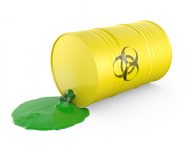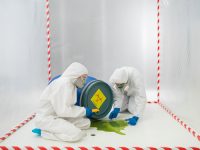Category: Chemicals
Today’s workplace uses thousands of chemicals, many of which are hazardous. The resources in this section will help guide you in the safe and legal identification, storage, transport, and use of these chemicals, and in making sure that your employees right to know how to be safe around such substances is provided, as required by law.
EPA Seeks Transparency for Hydraulic Fracturing Chemicals
Gas Detection: Hydrogen Sulfide Hazards and Releases
Hydrogen sulfide, or sour gas, is a flammable, colorless gas that is toxic at extremely low concentrations. It is heavier than air, and may accumulate in low-lying areas. It smells like “rotten eggs” at low concentrations and causes workers to quickly lose their sense of smell. Hydrogen sulfide, or sour gas, is a flammable, colorless […]
Gas Detection: Special Precautions for Hydrogen Sulfide
Hydrogen sulfide gas is very corrosive and therefore extremely hazardous. You need to take special precautions when choosing equipment and establishing safe work procedures. Hydrogen sulfide gas is very corrosive and therefore extremely hazardous. You need to take special precautions when choosing equipment and establishing safe work procedures. All oil and gas well drilling sites […]
Common HazCom Mistakes and Tips for Compliance
Hazard communication often figures prominently on OSHA’s annual Top 10 Violations list. Find out why so many employers fall short of HazCom requirements.
Responding to Chemical Spills: First Critical Actions
Taking immediate action after a chemical spill has been identified can prevent worker injuries and environmental damage.
Risk Management Plan FAQs
Facts about OSHA’s Lab Standard and Chemical Hygiene Plans
Yesterday, we describe eight elements that must be included in chemical hygiene plans. Today, we review more facts about the plans required under OSHA’s lab standard. OSHA’s Occupational Exposure to Hazardous Chemicals in Laboratories Standard (29 CFR 1910.1450) applies to all laboratories that use hazardous chemicals on a laboratory scale. A laboratory is defined as […]
8 Elements of a Chemical Hygiene Plan
If you’re required to have a chemical hygiene, make sure it contains these elements. Since 1990, OSHA has required facilities engaged in the use of chemicals in a laboratory to develop and implement a written chemical hygiene plan (CHP). OSHA requires these facilities to set forth procedures, equipment, PPE, work practices, training, and policies to […]








